AP State Board Syllabus AP SSC 10th Class Social Studies Important Questions Chapter 5 Indian Rivers and Water Resources.
AP State Syllabus SSC 10th Class Social Studies Important Questions 5th Lesson Indian Rivers and Water Resources
10th Class Social 5th Lesson Indian Rivers and Water Resources 1 Mark Important Questions and Answers
Question 1.
1. What are the twin sources of ‘Ganga’?
Answer:
The twin sources of Ganga are:
- Bhagirathi,
- Alakananda
![]()
Question 2.
Why are the Himalayan rivers called perennial?
Answer:
Himalayan rivers are called perennial because they flow throughout the year.
Question 3.
Suggest two activities that can be taken up so that the groundwater can be restored.
Answer:
The following activities are suggested to restore the ground water.
- Check dams,
- Percolation tanks,
- Loose boulder structures,
- Plantations on forest lands and roadsides etc. (Any two you can write).
Question 4.
What are the tributaries of the Indus river?
Answer:
The tributaries of the Indus river are the Jhelum, the Chenab, the Ravi, the Beas, and the Sutlej.
Question 5.
Name any two tributaries of river Indus.
Answer:
Jhelum, Chenab, Ravi, Beas, Sutlej.
Question 6.
What are the two branches of south-west monsoons which bring rains to India?
Answer:
The two branches of south-west monsoons which bring rains to India are
- The Arabian sea branch
- The Bay of Bengal branch
Observe the map given and answer questions 7 and 8.
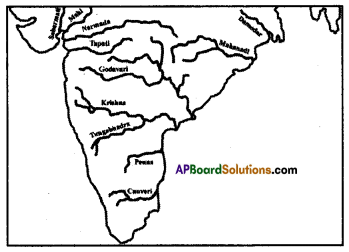
Question 7.
Name the two rivers that flow into the Arabian sea.
Answer:
The rivers that flow into the Arabian sea are
- Sabarmati
- Mahi
- Narmada
- Tapati
![]()
Question 8.
Through which states, river Tungabhadra flows?
Answer:
River Tungabhadra flows through Karnataka, Telangana, and Andhra Pradesh
Question 9.
Observe the map and answer the questions below?

a) Which river is shown in the map?
b) Which state does the river form a delta?
Answer:
a) River Godavari
b) Andhra Pradesh.
Question 10.
What are the three physiographic units of the drainage of India?
Answer:
- The Himalayas
- The Peninsular Plateau and
- The Indo-Gangetic plain
Question 11.
Divide the Indian drainage system on the basis of its origin.
Answer:
- The Himalayan rivers.
- The Peninsular rivers.
Question 12.
Name the three Himalayan rivers. (OR)
Mention the three principal river system to which the Himalayan Rivers belong.
Answer:
- The Indus
- The Ganges
- The Brahmaputra
![]()
Question 13.
Which rivers are perennial? Write the reason.
Answer:
The Himalayan rivers are perennial. This is because the rivers are supplied on rainfall as well as the melting snow.
Question 14.
Where does the Indus originate? What is its route?
Answer:
The Indus originates in the northern slopes of the Kailash range in Tibet near lake Manasarovar. It follows a north-westerly course through Tibet.
Question 15.
Where does the Indus enter India?
Answer:
It enters Indian territory in Jammu and Kashmir.
Question 16.
What do the water resources require?
Answer:
The water resources require both collective action at the local level and appropriate laws and policies at the state and national level.
Question 17.
What is the significance of ‘Devaprayag’?
Answer:
Bhagirathi and Alakananda join at ‘Devaprayag’ to form the Ganga.
Question 18.
Where does the Brahmaputra rise?
Answer:
The Brahmaputra in Tibet rises from the snout of the Chemayungdung glacier of the Kailash range near Manasarovar.
Question 19.
Where does the Brahmaputra enter India?
Answer:
The Brahmaputra enters in a great loop southwest through Arunachal Pradesh in India, first as Siang and then as Dihang.
![]()
Question 20.
What are the two tributaries of the Brahmaputra?
Answer:
The Dibang and the Lohit are the two tributaries of the Brahmaputra.
Question 21.
Where do the peninsular rivers originate?
Answer:
The peninsular rivers the Krishna, the Godavari and the Cauveri originate in the Western Ghats. The Mahanadi originates in the Vindhya Satpura ranges.
Question 22.
Which is the largest peninsular river system?
Answer:
The Godavari is the largest peninsular river system.
Question 23.
What is the source of the river Godavari?
Answer:
The source of the Godavari is in the Triambak plateau near Nasik in Maharashtra and discharges its water into the Bay of Bengal.”
Question 24.
Write the ‘inflow’ as a formula?
Answer:
Inflow = Precipitation + Surface flow + Groundwater flow.
Question 25.
What is called evaporation?
Answer:
The turning of water into vapour is called evaporation.
Question 26.
What is called transpiration?
Answer:
Living things give off water into the atmosphere through their breathing process, this is called transpiration.
![]()
Question 27.
What is called evapotranspiration?
Answer:
The total amount of water added to the atmosphere from both evaporation and transpiration is called evapotranspiration.
Question 28.
When would the surface flow increase?
Answer:
The surface flow would increase during the monsoon months.
Question 29.
How does the water reach the root zone of crops?
Answer:
Water reaches the root zone of crops either through rainfall or some process of irrigation.
Question 30.
Which kind of water is the vital need?
Answer:
Water used for drinking, cooking, washing, cleaning and for animals is vital need.
Question 31.
Name the surface storages.
Answer:
Tanks, ponds, lakes, etc. are the surface storages.
Question 32.
What is the question that we face today about the groundwater?
Answer:
The question that we face today is the depletion of groundwater storage and tendency not to care about the availability for future generations.
Question 33.
What are the two parts of the Tungabhadra basin?
Answer:
- The upper and middle catchment in Karnataka and
- The lower portion of the catchment in Andhra Pradesh.
![]()
Question 34.
Which water is available to us?
Answer:
The annual flows and stocks that recharge wells and tubewells is the water that is available for us.
Question 35.
When can the mining water be done?
Answer:
The mining water can be done only in extreme drought situations and replenished in good rainfall years.
Question 36.
How are the low portions of the Tungabhadra basin characterized in Andhra Pradesh?
Answer:
They are characterized by low rainfall and drought.
Question 37.
What is the result of the encroachment of public land for cultivation?
Answer:
It results in more land being brought under cultivation at the expense of tree cover.
Question 38.
What is the result of the rampant felling of trees and mining activity?
Answer:
Rampant felling of trees and mining activity is resulting in forest degradation, along with the destruction of the habitat of highly threatened flora and fauna.
Question 39.
Why did the Tungabhadra basin lose its water storage capacity?
Answer:
With the accumulation of silt due to mining, dust, soil erosion, debris the Tungabhadra Dam lost its water storage capacity.
Question 40.
How is water shared?
Answer:
Water is shared based on agreements between state governments.
Question 41.
What is the result of industrialization and urbanization?
Answer:
While increased industrialization and urbanization have improved standards of living for some, the same activities have caused pollution, especially by industrial units.
![]()
Question 42.
Why do the interstate disputes arise between Andhra Pradesh and Karnataka?
Answer:
Interstate disputes between Andhra Pradesh and Karnataka arise due to the trans-boundary nature of the river.
Question 43.
Where is Hiware Bazar located?
Answer:
Hiware Bazar is located in the Ahmednagar district in Maharashtra. It is situated on the eastern side of the Sahyadri mountain ranges that run north-south and separate Konkan, the coastal region, from the rest of Maharashtra.
Question 44.
Expand CCT.
Answer:
Continuous Contour Trenches.
Question 45.
Why were CCTs dug?
Answer:
The CCTs were dug on the hill slopes to arrest the erosion of soil, harvest water and encourage growth of grass.
Question 46.
Name some water harvesting structures.
Answer:
Check dams, percolation tanks and loose boulder structures.
Question 47.
Name the four bandis.
Answer:
- Kurhad bandi
- Charai bandi
- Nasbandi
- Nashabandi
Question 48.
What are the other bans which were added later?
Answer:
- The ban on borewells for irrigation,
- Growing sugarcane and banana and
- Selling one’s own land to any outsider.
Question 49.
Why do the farmers in Hiware Bazar keep rainfall data meticulously?
Answer:
They keep rainfall data meticulously and use it for crop planning and water use prioritization.
![]()
Question 50.
What happens when there is so much extraction of water?
Answer:
When there is so much extraction, it affects others in connected areas. It affects the stock of water that would be available for future generations.
Question 51.
What laws and regulations are needed for water consumption?
Answer:
Drinking water is the first priority as well as a human right and that, Panchayati Raj institutions must have control over the use of groundwater.
Question 52.
Which judgments illustrate the confusion over our laws today?
Answer:
The judgments in the case of Perumatty Gram Panchayat in Kerala and Coca Cola company illustrate the confusion over our laws today.
Question 53.
What do water resources require?
Answer:
The water resources require both collective action at the local level and appropriate laws and policies at the state and national level.
10th Class Social 5th Lesson Indian Rivers and Water Resources 2 Marks Important Questions and Answers
Question 1.
The Himalayan rivers are perennial, which means these rivers are filled with water throughout the year.
What are the two reasons that they are called perennial rivers?
Answer:
- The Himalayan rivers are perennial rivers as a result of the melting of ice and glaciers.
- During rainy season they depend on rainfall.
So they are filled with water throughout the year.
![]()
Question 2.
Observe the map and answer the following questions.
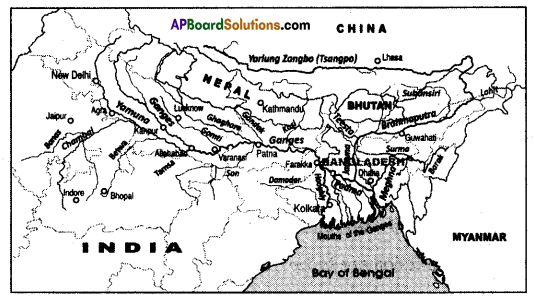 a) What is the River Ganga called in Bangladesh?
a) What is the River Ganga called in Bangladesh?
Answer:
River Padma.
b) On the banks of which River is Kolkata situated?
Answer:
River Hooghly. (Hugly)
Question 3.
Create two slogans on water conservation or the importance of water. (OR)
Write two slogans to bring awareness on saving of water in consumption.
Answer:
a) Save water – Save future.
b) Without water – there’s no future.
(Students can create a few of their own)
Question 4.
What were the conditions set by the Maharashtra government for the selection of villages under Adarsh Gram Yojana?
Answer:
The conditions set by the Maharashtra government for the selection of villages under the Adarsh Gram Yojana are
- Kurhad bandi – ban of felling trees
- Charai bandi – ban of free grazing
- Nasbandi – family planning
- Nashabandi – ban on liquor
- Shramadan – voluntary physical labour.
Question 5.
Categories the drainage system based on its origin.
Answer:
On the basis of the origin, the drainage system in India is categorized into

Question 6.
Suggest measures to be taken to conserve water.
Answer:
Measures to conserve water:
- Check dams
- Percolation tanks
- Loose boulder structures
- Plantation
![]()
Question 7.
Give a few suggestions for the betterment of groundwater level in Telangana in the present situation.
Answer:
- All people should maintain rainwater harvesting pits.
- They should construct and maintain check dams. The government should take responsibility.
- Continuous contour trenches are to be built up.
- Silt is to be removed every year from the tanks.
- Plantation should be taken up seriously.
- Digging of deep borewells should be avoided.
Question 8.
Even in years of continuous drought, there was no drinking water shortage in Hiware Bazar.
What are the reasons for this?
Answer:
- The main thing is the social control over groundwater extraction and no bore-wells usage for irrigation, no water-intensive crops like sugarcane.
- Water for irrigation was taken only through dug wells.
- They also worked out certain thumb rule type of things like if they get good rainfall, then they can take full rabi crop; if the rainfall is less, then they bring down the area under rabi crop etc.
- They keep rainfall data meticulously and use it for crop planning and water use prioritization.
Question 9.
As a student, how do you save water in your house and in your school?
Answer:
- Make it a classroom activity to check for leaks regularly.
- Install rainwater tanks.
- Fix any leaking taps, toilets.
- Raise awareness of the importance of water.
Question 10.
Create a poster on water importance.
Answer:
WATER IS LIFE

Water has been important for people for thousands of years. Without water there would be no life on earth.
We use water in our houses for cooking, bathing and washing the dishes. Water is used to grow food. In many dry areas farmers must bring water to the fields through canals and expensive irrigation systems.
Industries and factories also use water. Fruits and vegetables must be cleaned before they can be processed and sold in supermarkets. Water is used for cooling in many areas, for example in steel production.
Many countries around the world use water to produce energy. Power stations burn coal which turns water into steam. Countries with many mountains and rivers use the power of water to produce electricity.
Water is important for our free time. People enjoy themselves at seaside resorts or on cruise trips.
Transportation was at first carried out on waterways. Ancient civilizations traded goods across the Mediterranean Sea. Today oil, coal, wheat and other products are transported on waterways.
![]()
Question 11.
Write about the drainage of India.
Answer:
The drainage of India has evolved and adjusted itself with the evolution of the three physiographic units:
- the Himalayas
- the Peninsular plateau and
- the Indo- Gangetic plain. On the basis of its origin, the drainage system in India can be broadly divided into two categories,
i) The Himalayan rivers and ii) The Peninsular rivers.
Question 12.
“Rivers of India play an important role in the lives of the Indian people” – Comment on it.
Answer:
- The river system provides irrigation, potable water, cheap transportation, electricity and livelihoods for a large number of people all over the country and to rural areas.
- This easily explains why nearly all the major cities of India are located by the banks of rivers.
- Several major rivers along with their tributaries make up the river system of India.
- So rivers of India play an important role in the lives of the Indian people.
10th Class Social 5th Lesson Indian Rivers and Water Resources 4 Marks Important Questions and Answers
Question 1.
In which place has the water level gone down in your area? What are the reasons for the reduction of water levels according to your opinion?
Answer:
The water level has gone down in many of our areas. The groundwater is useful for both domestic purpose and for agriculture. If groundwater is not available, there will be many problems.
My opinion is that because of modernization of agriculture motor pumps of high horsepower are being used. Very deep borewells cause for drawing out water from the ground. Water has become a source of business. Many multinational companies draw water and sell in the form of bottles. Water conservation is also a major issue and it is taken as a serious one.
![]()
Question 2.
Explain any four river systems of India in the prescribed table form.
| Sl No. | Nameof the River | Origin or Birth place | Direction of Flow | Tributaries | Flow through which States |
Answer:
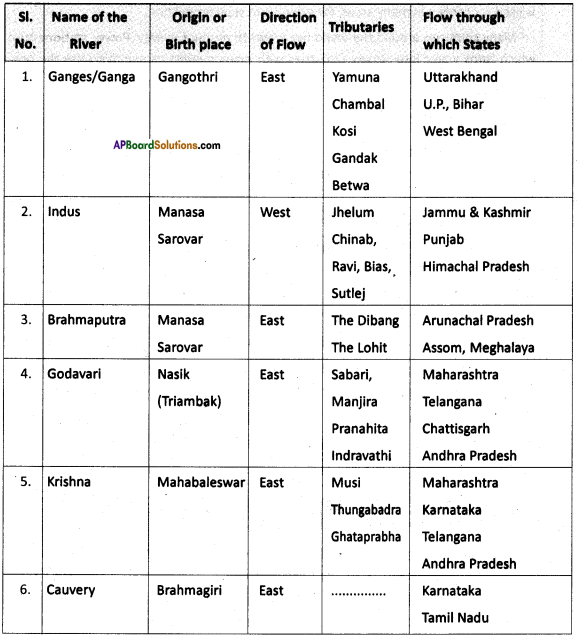
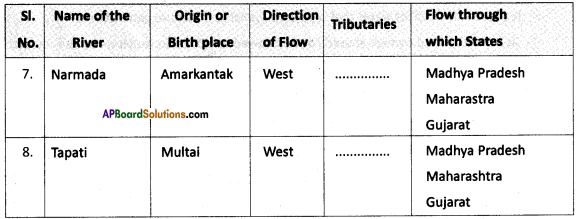
Question 3.
Today underground water is the main source of water for people. When there is so much extraction it affects others in connected areas. It affects the stock of water that would be available for future generations. Therefore one can’t allow individual land owners to extract as much water as they wish from the land. There should be some restrictions.
Do you agree, with this? Write your opinion.
Answer:
Yes. I agree with this statement.
- Water should be treated as a common pool resource.
- There are no boundaries in the flowing water underground.
- Land ownership should not be applied to underground water.
- Drinking water should be the first priority as well as a human right.
- Panchayat Raj Institutions must have control over the use of groundwater.
![]()
Question 4.
“The current laws about groundwater in many states are both outdated and inappropriate. They were developed at a time when groundwater was a marginal source of water. Today shallow and deep tubewells have the potential to draw a lot of water.”
Write your comment on the judicious way of using and equal distribution of groundwater and suggest few measures in this regard.
Answer:
- Today underground water is the major source of water for people.
- When there is so much extraction, it affects the stock of water that would be available to future generations.
- Therefore the landowners cannot be allowed to extract as much as they wish from their land. There should be some restrictions.
- These restrictions will be acceptable if we first delink the connection between ownership of land and water drawn through tube wells on the land.
Question 5.
“Usage of water without keeping in view about the future leads to non-availability of underground water for future generations.” Comment.
Answer:
- Today groundwater is the major source of water for people.
- When there is so much extraction, it affects others in connected areas.
- It affects the stock of water that would be available for future generations.
- So individual land owners should not be allowed to extract as much water as they wish.
- There should be some restrictions.
- The relation between the land ownership and the extraction of water should be delinked.
- They only the restrictions will be implemented properly.
- Groundwater should be treated as a common pool resource.
![]()
Question 6.
Read the following paragraph and write your opinion on it.
What is required are laws and rules to recognize that water is common flowing resource? Drinking water is the first priority as well as a human right and that Panchayat Raj institutions must have control over the use of groundwater.
Answer:
In my opinion.
- Groundwater benefits a wide range of people and the environment.
- But there are number of threats to the sustainability of this natural resource, which are compounded by a lack of understanding it.
- Groundwater is often seen as a resource that can be drawn on when surface water is scarce.
- Due to over use of groundwater the quality of water is deteriorating.
- If the people drink that polluted water, they will get diseases.
- Drinking water is the first priority as well as a human right.
- So, the Panchayat Raj institution think about water is common flowing resource at the same time these institutions have control on groundwater for the sake of future generations and provide it equitable manner.
Example: In Kerala, Perumatti grama panchayat, the Panchayat Raj institution give first priority to drinking water and next will give importance to Cocacola company. Here, the people’s health is most important.
Question 7.
Read the following paragraph and write your opinion on it.
Today, this is the major source of water for people. When there is so much extraction, it affects others in connected areas. It affects the stock of water that would be available for future generations. Therefore, one can’t allow individual landowners to extract as much water as they wish from their land. There should be some restrictions. These restrictions will be acceptable if we first delink the connection between ownership of land and water drawn from the underground system through tube-wells on the land.
Answer:
- Today groundwater is the main source for people.
- But excessive extraction of the groundwater is more effect to not only present people but also future generations.
- But there are no appropriate laws to regulate the usage of the groundwater resources.
- All the present laws were designed when the usage was minimum.
- The owner of the land is not the owner of the groundwater beneath his land.
- A link should be designed between the land ownership and control.
- The government should control the individuals in using underground water resources.
![]()
Question 8.
Explain the use of water in the river basin of Tungabhadra.
Answer:
- River water of Tungabhadra is shared by Karnataka, Telangana and the Andhra Pradesh States.
- Approximately 80% of rural area people are dependent on agriculture with Tungabhadra water.
- In some areas people constructed storage tanks based on Tunghabhadra water.
- Surface flows by canals that carry water from dams built along Tungabhadra in other areas.
- More land is brought under cultivation at the expense of tree cover.
- There are 27 large industries and 2543 small industries are depend on Tungabhadra water.
- It provides supply of drinking water to neighbour areas.
- Improved standard of living for some.
- Disputes also arised between Karnataka and Andhra on the base of availability of water.
Question 9.
Explain the Himalayan river systems.
Answer:
Himalayan River Systems
The Indus system, The Ganga system and the Brahmaputra system come under the Himalayan river systems:
- The Indus System: The Indus originates in Kailash range near Manasarovar. It enters Indian territory in Jammu and Kashmir. The Ravi, the Jhelum, the Chenab, the Beas and the Sutlej are its tributaries.
- The Ganga System: The Ganga is formed joining Bhagirathi with Alakananda which join at Devaprayag. It has large number of tributaries.
- The Brahmaputra System: The Brahmaputra rises from Kailash range near Manasarovar. It covers Tibet, and joins Arunachal Pradesh in India. It has different names in different places and is known as the Brahmaputra. The Dibang and the Lohit are its tributaries.
Question 10.
Read the given paragraph and write your opinion.
Regulation is not easy. This is also because for some resources like water, electricity, oil, natural gas, etc. consumption by one person or a sector affects what is available for others. In fact, in a number of states, the answer to falling water tables has not been to address the issue itself. State governments have thus often chosen to increase power subsidies to make extraction of ever deeper layers of groundwater possible.
Answer:
The given paragraph says that the regulation of natural resources like water, natural gas, etc. is not easy. Gradually water table is decreasing. Governments increase power subsidies to make extraction of ever deeper layers of ground water possible.
My interpretation is that water, electricity, oil and natural gas are essential for all people. These are to be used in control. Whatever we use should be useful to the next coming genera¬tion. Natural resources are sustainable. They can be useful to all generations. Water is an essen¬tial commodity. It is the people who decide the future. For a few decades we have been observ¬ing that more groundwater is being pumped out. Sinking water is gradually decreasing. In forests also water is not available. So monkeys, leopards are coming to villages. Deforestation is increased. Quarrying is also increased. Clouds are coming but they are not giving rain. Temperature is increasing day by day. People should understand the need of the future and act accordingly. Per head consumption is increasing drastically. Water conservation is an essential one. Not only human beings, birds, animals, plants also depend on water. Water harvesting pits are promoted at every house. Water shed programs are to be taken up. Every drop of water should be caught perfectly and saved with proper proposals. Government concentrates on the conservation of water to make the next coming generation happy.
Question 11.
“India is heading towards water scarcity.” Trace the possible solutions to tackle this problem.
Answer:
- Construction of multi purpose projects and canals.
- Solving river water disputes quickly.
- Inter-basin transfer of water.
- Measures to raise the underground water table.
- Rainwater harvesting.
- Watershed development.
- Avoiding pollution of water bodies.
- Preventing the wastage of water.
- Interlinking of Rivers.
![]()
Question 12.
Read the following paragraph and state your opinion on it.
Encroachment of public lands for cultivation is common. It results in more land being brought under cultivation at the expense of tree cover. Rampant felling of trees and mining activity is resulting in forest degradation, along with the destruction of the habitat of highly threatened flora and fauna. Inflows of groundwater depend on the tree cover in the catchment areas. Inadequate tree hover leads to water run-off as surface flow without getting a chance to recharge the underground system. Moreover, this also causes flash floods. If we wish to be fair to both the rainfed and canal irrigated regions, we must adopt a different plan for water conservation and a system of sharing water.
Answer:
- In recent years public land is brought under cultivation at the expense of tree cover.
- The felling of trees and other mining activities threatened flora and fauna.
- The inadequate free cover leads to water run off.
- There is less chance for recharging groundwater.
- It causes flash floods.
- The felling of trees threatened flora and fauna.
- Hence we must be alert and adopt a different plan for water conservation.
Question 13.
Read the para and answer the following questions.
Let us see the dispute over water use between the Perumatty Grama Panchayat in Kerala and the Coca Cola Company. The Panchayat decided not to renew the license for extraction of water because of the lowering of the water table in neighbouring areas. There was also decreasing water quality to the extent that the local government primary health centre had concluded that the water was not fit for drinking. The issue was brought to the courts and is now pending in the Supreme Court as on January 2014. The two decisions given by the judges in Kerala gave two opposing views of groundwater regulation. The first judge found that groundwater is a public resource meant for all, and that the state has a duty to protect it against excessive exploitation. Additionally the judge made the link that drinking water is a priority. The second judge took a completely different perspective and asserted the primacy of landowners’ control over groundwater. These two contradictory decisions illustrate the confusion over our laws today.
Answer:
- The para is an example of the confusion over our laws today.
- The Coca Cola company was extracting more and more underground water.
- This was reducing the groundwater levels and the water is getting polluted.
- The issue was brought to the court.
- Two judges gave contradicting judgments.
- The first judge stated that the state has a duty to protect it against excessive
- The second judge insisted the primacy of landowners’ control over groundwater.
- Hence we can conclude that there should be some clarity regarding the laws relating to ground-water.
- The laws are outdated and inappropriate.
- There should not be any contradiction regarding public interest.
Question 14.
Read the following paragraph and write your comments.
During the fast two decades there has been an increasing trend in the number of small towns and industrial areas. This has made the competing demands for water more complex. While increased industrialization and growth of urban areas have improved standards of living for some, the same activities have caused pollution especially by industrial units.
Answer:
- According to the given paragraph, it is clear that urbanization leads to water problems.
- Another point is that some people are leading prosperous life whereas many poor people are facing the problems of pollution.
- In my opinion, in this modern age urbanization has become mandatory.
- People from villages are coming to cities and towns for different reasons.
- Education for children, medical facilities and different livelihoods are the needs of the rural people.
- As they come to cities and towns they face the problems of basic need like food, water, shelter and cloth.
- In conclusion I don’t say that urbanization is not necessary but the problems of the poor migrants also should be considered.
- At industries and working cites water facility is to be provided.
- In all the areas protected water supply is necessary.
![]()
Question 15.
Read the following paragraph and write your comment on it.
Over the past few decades groundwater has become the main source, especially for domes¬tic use and agriculture. This tremendous increase in the use of groundwater has significant impact on water availability and access to it.
Answer:
- According to this paragraph the groundwater level is the crucial one to all the people.
- The groundwater is useful for both domestic purpose and for agriculture.
- If groundwater is not available there will be many problems.
- My opinion is that because of the modernization of agriculture motor pumps of high horsepower are being used.
- Very deep bore wells cause for drawing out water from the ground.
- Water has become a source of business many Multinational companies draw water and sell in the form of bottles.
- Every individual should think about the importance of water as it is useful to all people.
Question 16.
Read the following paragraph and comment on it.
Current laws on groundwater use are inappropriate because the basic links between access to groundwater and land ownership on which these rules are based are flawed. Since groundwater has to be extracted from the land above, a link was established between land ownership and control.
Answer:
- The given paragraph says that the current laws are not appropriate and there is no link between accesses to groundwater and land ownership.
- Proper laws are to be made and implemented otherwise there will be a mass problem of water.
- I would like to comment on this paragraph that current laws are not being implemented in a right way.
- The government should have true spirit of implementation of laws. There are so many laws made in the time of the British rule.
- After independence these would have been modified or changed according to the present needs or new laws according to the situations and necessities have to be made time to time. This was not done.
- The government should take necessary action to bring in new laws and they should be implemented in a right way.
Question 17.
People are facing the problem of water scarcity in all the areas. It may be there in your locality also. Write a note on the condition of water scarcity that you recently observed.
Answer:
- Scarcity of water has become a common problem everywhere.
- People of all corners are facing the same problem.
- They purchase even two glasses of water by paying twenty or twenty five rupees.
- Human activities like deforestation, using plastic, cement and concrete roads are a few rea¬sons for the depletion of groundwater level.
- Deforestation leads to low rainfall.
- Rainwater is not percolated properly because of two reasons.
- By constructing small check dams, it is better to store the water and so it could be useful to restore the groundwater.
- Then it will be expected that drinking water is available.
Question 18.
Observe the map and answer the following questions.
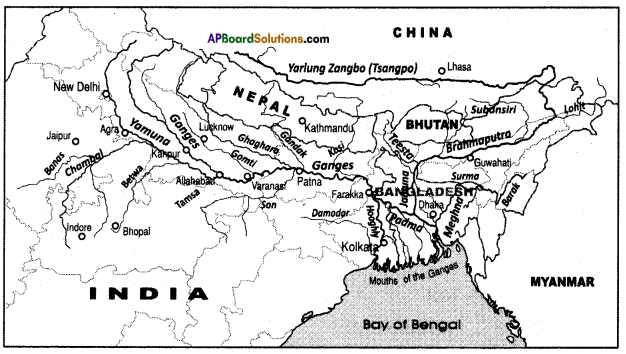 a) Mention any two tributaries of river Ganga.
a) Mention any two tributaries of river Ganga.
Answer:
Gandak, Ghagra, Gomati, Son, Betwa, Chambal, Yamuna are the tributaries of river Ganga. (Any two can be written)
b) River Brahmaputra joins a river before joining into Bay of Bengal. What is the name of the river?
Answer:
The river in which the Brahmaputra joins is the Ganga.
c) Two countries are sharing the water of the river Teesta. What are the two countries?
Answer:
India and Bangladesh.
d) Which river is called ‘Padma’ in Bangladesh?
Answer:
River Ganga.
![]()
Question 19.
Locate the following in the given map of India.
- Brahmaputra river
- Drainage area of Indus river
- Nagarjuna Sagar Dam
- The project on Sutlej river
Answer: Bhakra Nangal - The river which is parallel to river Narmada.
Answer: Tapti - The lake which in between Krishna and Godavari rivers.
Answer: Kolleru - Locate Hiware Bazar.
- Konkan Coast.
- The Coast of Tamilnadu
Answer: Coromandel - Capital of Madhya Pradesh.
Answer: Bhopal
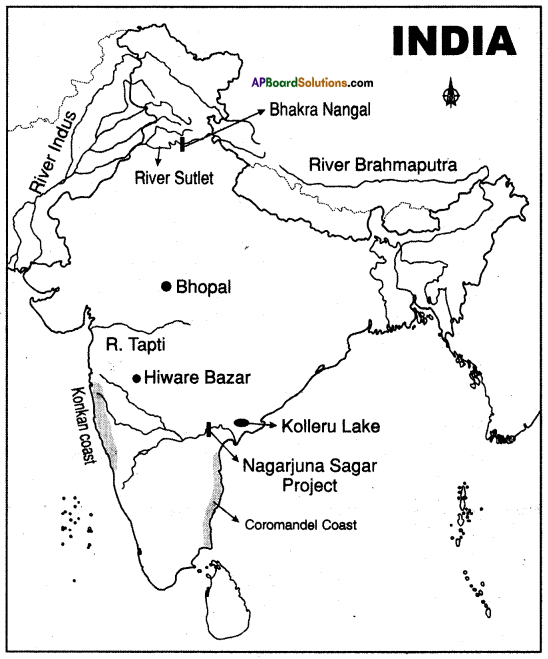
![]()